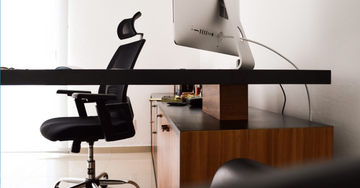How to Adjust Your Office Chair for Perfect Posture (A Step-by-Step Guide)
by Khent Barangas on Sep 11, 2025

You can buy the fanciest chair in the store, but if it is not adjusted properly, it will not do your body any favors. Achieving proper desk posture is less about the price of your chair and more about how you set it up to support you.
The challenge is that no single setup works for everyone. What feels ergonomic for one person may not feel the same for another. So, it’s important to adjust your chair to match your height and body proportions.
In this guide, we will walk through a step-by-step process on how to adjust your office chair. From seat height to lumbar support, you will learn the best chair settings for correct sitting posture.
Why Ergonomics and Proper Office Chair Setup Matter?

Workstation setup can either keep you comfortable or cause you pain. Poorly designed workstations, especially when sitting for long hours, are one of the leading causes of musculoskeletal problems.
Research backs this up. A study by Mantooth, Zhu, & Mehta (2017) found that office furniture without adjustable features could increase the risk of musculoskeletal disorders, even leading to problems like nerve compression.
Among all elements of a workstation, the chair is often the most practical and affordable to improve, especially since changing desks or work surfaces is not always an option.
And because your chair directly affects posture, even small tweaks can make a noticeable difference.
In fact, one systematic review found five studies showing that using better chairs can help reduce body pain in people who sit for long periods. Three of the studies were done in garment factories, one in an office, and one with university students.
However, adjusting your chair not only makes you feel better, but it also helps you work better.
In a study known as the “Leap Productivity and Health Impact Study,” employees who received both an ergonomic chair and training saw up to a 17.8% increase in productivity, while those with training alone showed no change.
Similarly, a 2022 study emphasized that chair design is one of the most critical ergonomic factors influencing employee performance and organizational competitiveness. In particular, features such as adjustability, lumbar support, and seat depth were found to play a vital role.
The good news is that these adjustable features are already standard in ergonomic chairs today, offered by Qoncept Living.
Step-by-Step Guide to Adjust Your Office Chair for Proper Posture
To truly sit comfortably and protect your body, you need to know how to adjust your chair correctly. Here’s how to set up your office chair for proper desk posture and all-day support.
Step 1: Set the Right Seat Height

When adjusting your seat, your goal is to have your feet flat on the floor and your thighs parallel to the ground. Here’s a clever way to find the right height of your chair:
- Stand in front of your chair.
- Use a lever or pneumatic control to raise or lower the seat so its highest point is just below your kneecap.
- Sit all the way back in your chair
- Look at your knees. They should bend at about 90 degrees.
If your chair is too high and will not go lower, use a footrest for support.
Step 2: Position Your Chair Seat Depth Correctly

The space between the back of your knees and the chair seat should be 2-4 inches (about the width of your fist). Here’s how to adjust the office chair seat depth:
- Sit with your back against the chair's backrest
- Check the space between the back of your knees and the seat edge
- If your chair has an adjustable seat depth, slide the seat forward or backward
- For non-adjustable chairs, use a lumbar cushion to bring your back forward
Step 3: Adjust the Backrest Angle and Tension

Your goal in adjusting your backrest is to support the natural curve of your spine. This is an important step in chair ergonomics to prevent slouching and back pain.
Follow this lumbar support positioning guide:
- Locate the natural curve in your lower back.
- Adjust the lumbar support of your chair to fit snugly against this curve.
- The support should be positioned at belt level or slightly below.
- If your chair lacks built-in lumbar support, use a small pillow or lumbar cushion.
Keep in mind that different chair materials provide varying levels of lumbar support. For example, mesh chairs typically offer more flexible, breathable backing that conforms to your spine. Executive chairs may provide firmer support, though some models require additional lumbar cushions for optimal positioning.
Step 4: Adjust Office Chair Armrests Properly

Armrests were once discouraged because they often kept users from sitting close to their desks. That is why having an office chair like the Qoncept Erin with removable armrests is ideal for flexibility.
Chairs with armrests that extend 25 cm (10 inches) or less from the back of the seat are usually more suitable. If you have this type of chair, follow these steps:
- Sit upright with arms hanging loosely by your sides.
- Bend your elbows at about 90 degrees, then adjust the armrests until they just touch the undersides of your elbows
- Ensure armrests don't interfere with pulling close to your desk
If your armrests cannot be lowered enough and end up pushing your elbows upward, it is best to remove them altogether. This ensures a more relaxed ergonomic chair setup.
Step 5: Position Your Chair Relative to Your Desk

Create proper alignment between your chair, desk, and computer screen. Here’s how far you should sit from your desk:
- Pull your chair close enough that your elbows stay close to your body
- Your keyboard and mouse should be at elbow height
- Maintain 20-26 inches between your eyes and the computer screen
- The top of your monitor should be at or slightly below eye level
Final Checklist to Fine-Tune Your Office Chair Setup
To make things easier, we put together a simple checklist you can follow in adjusting your office chair. Before settling in, take a moment to review these points:
- Feet flat on the floor or footrest
- Knees at a 90-degree angle or slightly less
- Back supported by lumbar support
- Shoulders relaxed, not hunched
- Elbows close to the body at a 90-degree angle
- Head upright, not tilted forward
- Computer screen at eye level
Frequently Asked Questions
What height should an office chair be for proper posture?
Your chair height should allow your feet to rest flat on the floor with your thighs parallel to the ground and knees at approximately 90 degrees.
Can proper chair adjustment really reduce back pain?
Yes, studies show that ergonomic chair setup can significantly reduce lower back pain and improve overall comfort during extended sitting periods.
What if my office chair doesn't have all these adjustment features?
Focus on the adjustments available to you, and supplement with ergonomic accessories like lumbar cushions, footrests, or armrest pads.
If you're shopping for a new chair with better adjustability, browse our chair collection to find models with comprehensive ergonomic features.
Get a Proper Office Chair Setup
Learning how to adjust your office chair for proper posture is an investment in your long-term health and daily comfort. This step-by-step guide provides everything you need to create an ergonomic workspace that supports your body's natural alignment.
Remember, the perfect office chair setup is personal to your body dimensions and comfort preferences. Take time to experiment with different settings and make small adjustments until you find what works best for you.
Ready to set up your ergonomic office? Explore our ergonomic furniture collection today. You can also visit our Shopee and Lazada for a convenient shopping experience.









